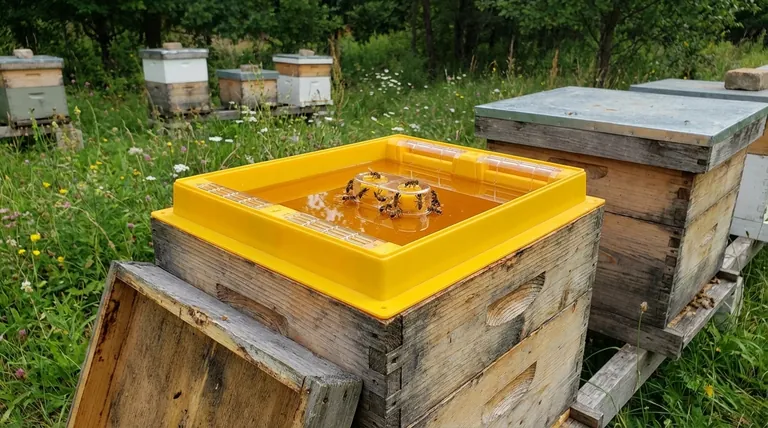In short, top feeders are significantly faster and less disruptive to fill and refill than gravity or frame feeders. Their wide, open design allows a beekeeper to pour large volumes of syrup quickly by simply removing the hive lid and inner cover. This process minimizes disturbance to the colony and reduces the risk of spills that can attract robber bees.
The fundamental difference lies in access. Top feeders provide direct, open access from above the colony, making refilling an efficient and low-stress event for both the beekeeper and the bees. Frame and gravity feeders, by contrast, often require more manipulation or present a higher risk of spillage.

The Core Design Difference: Access and Disruption
The efficiency of refilling a bee feeder is determined by its placement and design. Each type presents a distinct process with unique implications for the hive.
The Top Feeder Method: Minimal Intrusion
A top feeder sits directly on top of the uppermost hive box, just under the main cover.
Refilling involves removing the outer and inner covers to expose the feeder's large reservoir. The syrup can be poured in quickly and easily, without disturbing the frames or the brood nest below.
The Frame Feeder Method: Inside the Brood Box
Frame feeders, as the name implies, are designed to take the place of one or two frames inside a hive box.
To refill one, the beekeeper must open the hive completely. This exposes the colony to the elements and is significantly more disruptive than refilling a top feeder.
The Gravity Feeder Method: External but Prone to Spills
Gravity feeders, such as entrance feeders or feeding pails, are placed outside the hive or on top of an inner cover hole.
While they don't require fully opening the brood box, they must be inverted to function. This action, combined with potential temperature fluctuations and bad seals, can easily lead to leaks and spilled syrup on the ground, creating a magnet for robber bees.
Key Advantages of the Top Feeder Design
The simple, direct-access design of a top feeder translates into several practical benefits for hive management.
Speed and Efficiency
The ability to pour syrup into a large, open container makes the process exceptionally fast. This is a major advantage for beekeepers managing multiple hives or distant apiaries where time on site is limited.
Reducing Spills and Robbing
Because the syrup is contained within the hive's footprint and is easy to pour without dripping, top feeders dramatically reduce the chance of spills. Spilled syrup is a primary trigger for robbing, a dangerous situation where bees from other colonies attack a hive to steal its resources.
Reliability and Durability
Unlike gravity feeders that rely on vacuum seals, top feeders are not prone to leaking due to temperature changes. Their simple, basin-like construction makes them reliable for fall feeding when temperature swings are common.
Ease of Cleaning
The open design also makes top feeders exceptionally easy to rinse out and dry for storage once the feeding season is over.
Making the Right Choice for Your Goal
Selecting a feeder depends entirely on your management style, climate, and specific goals for the colony.
- If your primary focus is speed and minimal hive disruption: The top feeder is the clear choice for its unmatched ease of refilling.
- If your primary focus is feeding during cold or inclement weather: A frame feeder is often preferred, as it allows bees to access food without leaving the warmth and safety of the hive cluster.
- If your primary focus is avoiding leaks and preventing robbing: A top feeder's contained, non-pressurized design makes it a more secure and reliable option than most gravity-fed systems.
Ultimately, understanding how a feeder's design impacts your workflow is key to managing your colonies effectively and efficiently.
Summary Table:
| Feeder Type | Refilling Process | Key Advantage | Potential Drawback |
|---|---|---|---|
| Top Feeder | Remove outer cover; pour syrup into reservoir. | Fast, minimal hive disturbance. | Bees may not access food in very cold weather. |
| Frame Feeder | Open hive; remove frames to access feeder. | Food is inside the warm brood cluster. | Highly disruptive to the colony. |
| Gravity Feeder | Invert or refill external container. | Does not require full hive opening. | Prone to leaks and spills, attracting robbers. |
Upgrade your apiary's efficiency and safety with HONESTBEE's premium top feeders.
Designed for commercial beekeepers and distributors who value speed and colony health, our top feeders minimize refilling time and drastically reduce the risk of robbing. This allows you to manage more hives effectively and protect your valuable investment.
Ready to streamline your feeding process? Contact our wholesale experts today to discuss bulk pricing and how our durable beekeeping supplies can benefit your operation.
Visual Guide

Related Products
- Professional Hive Top Bee Feeder for Beekeeping
- HONESTBEE Professional Hive Top Bee Feeder Feeding Solution
- HONESTBEE Round Hive Top Bee Feeder for Syrup
- HONESTBEE Entrance Bee Feeder Professional Hive Nutrition Solution for Beekeeping
- Classic Boardman Entrance Bee Feeder Hive Front Feeding Solution
People Also Ask
- What types of hive boxes is the round hive top feeder compatible with? Universal Fit for 8 & 10-Frame Langstroth Hives
- What are the advantages of using top feeders for bees? Maximize Feeding Efficiency & Colony Safety
- What is a top feeder for bees? Maximize Colony Health with Efficient Feeding
- Why is a top feeder essential for bees? Ensure Colony Health and Efficiency
- What are the advantages of hive top feeders? Maximize Feeding Efficiency for Your Apiary



















